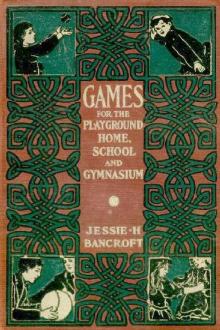Games for the Playground, Home, School and Gymnasium by Jessie Hubbell Bancroft (top novels of all time .txt) 📕

- Author: Jessie Hubbell Bancroft
- Performer: -
Book online «Games for the Playground, Home, School and Gymnasium by Jessie Hubbell Bancroft (top novels of all time .txt) 📕». Author Jessie Hubbell Bancroft
The captain and players of the opposing group meanwhile keep a sharp lookout for the ball without leaving their seats.
After a short time of passing, the captain, who started the passing (Group B, diagram) calls suddenly, "Hands up!" and immediately all passing in Group A must cease, and all hands must be raised high overhead and tightly clinched, so the player having the ball, when the passing ceased, may not disclose the fact.
The B captain again gives a sudden command of "Hands down!" Immediately all hands are brought down softly on the desk in front of each player of Group A, hands wide open, palms downward, and again the player with the ball tries to hide it under his hand.
The players of Group B, who think they know who has the ball, raise their hands. No player may speak unless called by his captain. When called, he may say, "Under J.'s right hand" (or left hand, as the case may be). J. raises the right hand, and if the guesser be mistaken, places that hand in his lap, it being thereafter out of commission, so to speak. No other player of Group A moves a hand. Should the ball be found under the hand raised, the opposing group, i.e. Group B, receives as many points as there are hands left upon the desks. Otherwise, the search continues, the captain of Group B asking players of his group to order a hand raised, or orders it himself, until the ball is discovered. Group B now takes the ball and passes it from one to another, and Group A gives commands through its captain. The side making a score of three hundred points wins. A side loses ten points when a player talks or calls for a hand to be raised without the permission or call of the captain.
This adaptation was made by Miss Adela J. Smith of New York City, and received honorable mention in a competition for schoolroom games conducted by the Girls' Branch of the Public Schools Athletic League of New York City, in 1906. It is here published by the kind permission of the author, and of the Girls' Branch, and of Messrs. A. G. Spalding & Brothers, publishers of the handbook in which the game first appeared.
HEN ROOST5 to 30 or more players.
Parlor; schoolroom.
Each of the players except one chooses a word, which should be the name of some object, and in answering any questions put to him in the game he must introduce this word which he has chosen into each answer. The odd player takes the place of questioner. He may ask one or more questions of each player, as he sees fit, the dialogue taking any turn he chooses, the following being suggestive of the general tone of it:—
The questioner says: "I heard that you got into the hen roost yesterday. How did you get in?"
Answer: "With the dictionary."
To the next player: "What did you find there?"
Answer: "A horse."
To the next player: "What did you give him to eat?"
Answer: "A sofa pillow," etc.
Any player who laughs, or who fails to answer promptly or correctly to the question, must change places with the questioner. Forfeits may also be required if desired.
HORNS5 to 60 players.
Indoors; out of doors; schoolroom.
This game is played very much like "Simon says." It is a quiet game that may be played with all of the players seated, their forefingers placed on their knees or on a table or desk in front of them. One who is leader says:—
"All horns up!"
"Cat's horns up!" or
"Cow's horns up!"
whereupon he lifts his own forefingers, pointing upward. Should he name an animal that has horns, all of the players lift their fingers in similar manner, but should he name an animal such as a cat, that has no horns, any player that lifts his fingers in imitation of the leader is out of the game.
INITIALS5 to 30 or more players.
House party.
For this game it will be necessary to prepare slips of paper, one for each player. At the head of the paper are written the initials of some person who will be present; under this a series of questions which the player drawing the paper is to answer. The papers are put in a box or hat and drawn by the players, or held in the hand with the initials concealed and drawn in that way. A certain time may be allowed, if desired, for the answering of the questions.
The answers must be written in each case immediately below the question, must consist of only as many words as there are initials at the top of the sheet, and the words of the answer must begin with the initials in their proper order. For example:—
Any number of players.
Out of doors; indoors.
A basket of leaves is provided, no two of the leaves being alike. These may be leaves from trees, shrubs, or plants, or flowers may be used in the same way.
The players are each provided with a card or slip of paper and a pencil, and are seated. One leaf is handed to the first player, who passes it on to the next, and so on until it has made the round of the group. Each player, in turn, if he can identify the leaf, writes the name of it on a card. Each leaf is thus passed.
The host or hostess then reads a correct list, naming the leaves in the order in which they were passed. The player wins who has the largest number correct.
This is an especially pleasing game for nature students.
LITERARY LORE5 to 30 or more players.
House party.
Each player is given a sheet of paper on which the following questions are written. The player wins who writes correct answers to the largest number of questions. This game may be worked up from the writings of any poet or author. Examples are given from Tennyson and Longfellow. The answers are appended here, but in playing the game should be read by the host or hostess at the end.
2 players.
Indoors; schoolroom; seashore.
This is a quiet game in which the players are all seated. A diagram is drawn on a slate or piece of paper of oblong shape, about six by ten inches in outside dimensions, if the surface admits of one so large. This is divided by a horizontal line every two inches. It is an advantage if the players have different colored pencils, but this is not necessary. A piece of paper is placed at the bottom of the diagram and blown over the diagram toward the top; or a small piece of glass or china called a "chipper" is used, the latter being nicked or snapped with the fingers. The first player snaps his chipper, and in whichever place it stops marks with a pencil a small round "o" to represent a man's head. The chipper is then returned to its starting place and the play is repeated. This is continued until the player has marked a head in each of the horizontal spaces; or should his chipper land a second time in a space in which he has already marked such a head, he makes a larger round under the head to represent the body of a man. The third time it lands in this place he makes a downward stroke for a leg, and the fourth time one for a second leg, which completes the man. Should three complete men be so drawn in one space, the player, without shooting again, draws what are called "arms," that is, a horizontal line from the figures across the space to the outside limits. This occupies the space completely and keeps the other player out of that space; that is, the other cannot put any men in it or add to any which he may already have started there.
The first player continues to play until the chipper lands on a line; a player whose chipper lands on a line or outside of the diagram loses his turn. The other player then takes his turn, and may start, continue, or complete men in any spaces which the first player has not occupied with three armed men, even though the latter may have started men in the space or have completed two of them. Each player may build only on his own men.
The player wins who succeeds in occupying the largest number of spaces with three armed men of his own drawing.
The space at the top of the diagram, called "London," is especially advantageous. No men are marked in it, but should the chipper land there at any time, the player may draw a head in every other space on the diagram, or add one mark to any one drawing he may have already in each space.
This game may be played on the seashore or playground or wherever the diagram may be drawn in hard earth.
For the schoolroom it is an interesting diversion for pupils who assemble early before the opening of the school session.
MINISTER'S CAT (THE)Any number of players.
Parlor; schoolroom.
The first player says, "The minister's cat is an avaricious cat," using an adjective which begins with "a" to describe the cat.
The next player makes a remark about the cat, using the same initial letter for the adjective; for instance, that it is an "aggressive" cat. This is continued, each player using a different adjective beginning with the letter "a," until the game has gone entirely around the circle. The first player then makes a similar remark about the cat, using an adjective beginning with "b." This goes around, and so on through the alphabet. Any player who is slow to respond, or who fails, must either drop out of the game or pay a forfeit, as may be decided at the start.
MUSIC BOX3 to 60 players.
House party; schoolroom; playground.
Each player is given a slip of paper and pencil. Some one who has a good repertoire of popular airs sits at the piano—or lacking a piano, may sing





Comments (0)